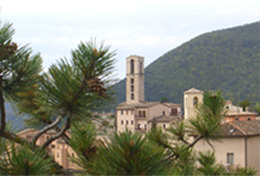
Activities events curiosity Cerreto di Spoleto
Main Events
Sagra del Ciarlatano - (Charlatans’ Fair)
Cerreto di Spoleto
Around August 15. It is possible to taste local specialties like the “fogliata”
Sagra del Fungo - (Mushrooms’ Fair)
Borgo di Cerreto
Organised to foster local mushroom production; with mushroom-based preparations can be tasted.
Weekly market on Monday
Fiera della Befana (Epifany’s Fair)
January 2
Fieretta (Small Fair)
January 22
Fiera di S. Nicola (St. Nicholas Fair) December 6
Other Events
- Canto della “Pasquetta”– municipality of Cerreto – January 5
S. Biagio – Fergino – First Sunday of February
-
S. Giuliana – Borgo Cerreto – Sunday after February 16
- Procession with the Dead Christ – Borgo Cerreto – Holy Friday
- Madonna delle Grazie – Triponzo – Sunday before the Ascension Day
-
Festa della Madonna – Bugiano – Ascension Day
-
Madonna dei Miracoli – Cerreto di Spoleto – Pentecost
-
Madonna di Costantinopoli – Collesoglio – Sunday of the Holy Trinity
-
SS Peter and Paul – Nortosce – June 29
- Madonna del Verde – Rocchetta – First Sunday of July
-
Madonna del Monte – Cerreto di Spoleto – Third Sunday of July
-
AVIS Day (Italian organisation of blood donors) – Cerreto di Spoleto – First Sunday of August
-
S. Lorenzo – Borgo Cerreto – August 10
-
Festa a Monte Maggiore – Cerreto di Spoleto – First Sunday of September
-
Madonna della Porta – Ponte – Second Sunday of September
-
Madonna Addolorata – Macchia – Fourth Sunday of September
-
“ Venuta” bonfires – municipality of Cerreto – December 9
Curiosity
PROFESSION OF THE CERRETANS
According to some plausible hypothesis, the word “Cerreto” comes from the word “cerro” (old term for “oak”): indeed, in the middle of the main square there was an oak and the whole mountain where Cerreto developed was covered by oak trees. The coat of arms for Cerreto is a two-sided shield with the picture of an oak between two climbing white bears. The head of each bear contains the emblem of the Orsini family. At their feet, a three-arched bridge crosses a river: this is a reference to the bridge over the Nera river. The bears indicate the familiarity between Cerreto and the noble Orsini family (“orso”=bear); they are white because this was the colour used by the supporters of the Emperor, the Ghibellines. The Italian Academy of the Crusca, in its 1612 dictionary, described the inhabitants of Cerreto as follows: “Cerretano”, a person who sells ointments or other drugs in the squares, draws teeth out and performs conjuring tricks , also known as “ciarlatano” (charlatan). …From the word Cerreto, a town in the Umbria region which was the birthplace of this kind of people, who used to earn their living by cheating.
FAMOUS CERRETANS
The Cerretans wandered around the Italian peninsula and beyond its borders: they were druggists and apothecaries who, taking advantage of people’s naïveté and good faith, sold empirical spices and miraculous ointments or pretended to be seriously ill so as to be given alms. They were forbidden to carry out these activities in 1577, when the authorities of the time, together with the College of Doctors in Perugia, banned the profession of “cerusico” (surgeon). Even Machiavelli, in his famous comedy “Mandragora”, uses the word “cerretan” as a synonym for “charlatan”, a false doctor who praises the virtues of the mandrake, the plant of the title. As early as the XV century, mgr. Teseo lists in a complete book the 39 specialised professions of the Cerretans, which include: sellers, cheaters and beggars. Cerretans were even deemed to use a mysterious language to speak to each other so as not to be understood by the people they wanted to cheat.




 +39 0575 62322
+39 0575 62322  +39 339 8023210 (Carmelita)
+39 339 8023210 (Carmelita)  Fax +39 0575 603206
Fax +39 0575 603206 